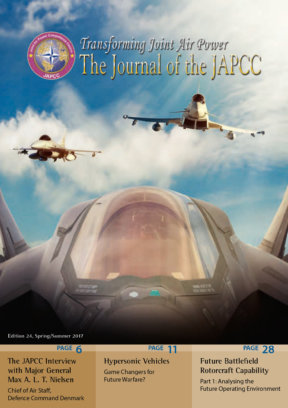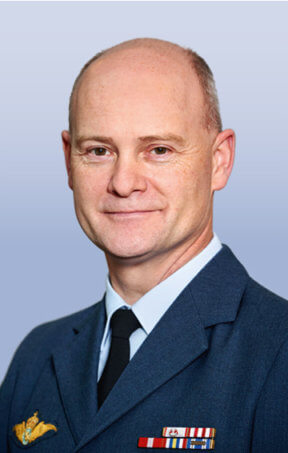The world has changed since the Russian annexation of Crimea. In this context, with a resurrected threat in the east, what it your primary focus for the Royal Danish Air Force?
After more than fifteen years of fighting terrorism, we have grown accustomed to being superior to our opponent in regards to our war fighting capabilities. In the near future, we must – once again – be ready to face an advanced and determined peer-level adversary, to ensure that if diplomacy and deterrence fail, we can fight and win our nations’ wars. To do this, we must elevate the capabilities of all platforms, by reviewing and rethinking them from a doctrine, organization, and technology perspective. In the Royal Danish Air Force, we believe that integration of the F-35 will increase the capabilities of all platforms, not only those of the Royal Danish Air Force, but also platforms in a joint and combined context. For instance, the F-35 is an excellent platform for gathering intelligence, both imagery and signal intelligence, thus being able to provide essential information to specific missions or information critical to Electronic Counter Measures on a theater level. In an Anti-Access Area Denial (A2AD) scenario, the F-35 will be able to operate in a hostile A2AD environment, and by suppressing, disrupting or defeating the enemies’ A2AD capabilities and networks, it will enable Friendly Forces to operate in the theater. In other words, we do not just see the F-35 as a new and more capable fighter, we also see it as a catalyst for our armed forces, enabling them to be more effective.
In order for us to be ready to face an advanced and determined peer-level adversary, we must revitalize some of the forgotten Cold War virtues and put them into a modern context. For the Royal Danish Air Force this means the necessity to increase our war fighting capabilities, thus our primary focus for the coming years is the successful implementation of the F-35. In this process it is essential that we do not force the F-35 to fit into the Royal Danish Air Force as is, but rather seek to make the combined Danish armed forces fit to benefit from the F-35. Only then will we be able to harness the true potential of this fighter of the future, and thereby hold the ability to prevail should the need arise.
If nations, like Denmark, who procure the F-35 will redesign their armed forces to optimize operations with a 5th generation platform like the F-35, how will this influence combined NATO operations, where many nations won’t have 5th generation capabilities and the bulk of forces are predominantly 4th generation?
At this moment, only a handful of NATO countries are destined to procure the F-35. At the same time we need to address the challenge of a limited number of air assets and a growing demand for Air Power. It is paramount that we utilize the F-35’s 5th generation capabilities for the greater good of NATO as a whole. Firstly, the F-35 will be the new spearhead to take on the most challenging tasks in the air and to confront enemy air defences. Secondly, we may also consider using the F-35 as a force multiplier e.g. in the role of forward Battlefield Managers. Through enhanced command and control, information sharing, and decision making, the F-35 can enhance and leverage the capabilities of 4th generation platforms in and above the battlefield. Information superiority is – as it has always been – one of the main measures of battlefield competition. 5th generation air platforms should form the nucleus of a joint and combined force leveraging information superiority to execute operations.
For many years to come, 4th generation platforms will continually form the backbone of NATO operations, while 5th generation platforms, like the F-35, will function as force multipliers, augmenting the collective effect of the whole of NATO operations. This will be much the same as we saw with the introduction of Airborne Warning and Control Systems (AWACS) and expect to see in the future with the Alliance Future Surveillance and Control capability. It is therefore imperative that we vigorously train operations with mixed 4th and 5th generation platforms so our combined NATO forces – during live combat operations – will be able to operate in unity.
The F-35 undoubtedly brings about many advantages, both in a national and an alliance context, but what are some of the challenges that you expect to see from a Danish perspective, with regards to operating the F-35?
The transformation from a 4th generation Air Force into a 5th generation Air Force is a challenge to both our nation and our alliance. To quote Air Marshal ‘Geoff’ Brown, former Australian Chief of Air Force: ‘We cannot be complacent, and assume that simply by having the F-35A aircraft we have a 5th generation capability. We need to think about how we employ our air combat forces, as a system of systems. Developing and evolving concepts and tactics that best exploit the new capabilities are vital.’ The core of this adaption and development is our airmen – the key element in all we do. Our ability to deliver effects is directly proportional to our ability to have the right personnel with the right attitude and qualifications, properly equipped at the right place and at the right time. If we fail to do this, we will not be able to deliver the desired effect, and thus we will fail. This is true in regard to every position in the chain, from the military security personnel to the pilots and the military commanders. Without skilled personnel, we cannot launch the jets, and thus we cannot provide Air Power. Consequently, we must ensure that our airmen are organized, trained, and equipped to face the challenges. It has long been a motto that we must ‘train as we fight’, but instead we should start looking at how we will fight in the near future, and start training for it today.
Since the fight of the near future is going to be different from the fight of today, it is absolutely essential that we have the proper means to train for it. The limited size of our training airspace and what we are able to replicate in live training is already a challenge for the fight of today, and will be even more so in regards to the fight of tomorrow. Therefore, we need to look at establishing larger training airspaces in northern Europe, which could serve as a frame for combined live training with players from all of NATO. In time, this must be complemented with a more comprehensive use of simulation than we have seen before, since many of the threats we need to train against, and the scenarios in which we need to train, only can be produced in a simulation environment.
From a national perspective, we are looking at ways and means to optimize the use of the F-35. With a limited amount of aircraft and considering the cost of flying hours, it is vital that we optimize the training output as much as possible. This in turn forces us to look at other options to achieve our training objectives e.g. in terms of red air support. One such option, which we must consider, could be to engage with a commercial partner to fill parts of the red air requirements. At the same time, in the first years to come, we must seek to increase the combined training across NATO countries, which would serve to both facilitate training with mixed 4th and 5th generation platforms and to provide high quality opponents to both platforms as well.
Looking a bit further into the future, we see great potential in Live, Virtual and Constructive (LVC) training. If we can manage to overcome the issues of classification and the technicalities of linking our assets, we will have a powerful tool to ensure increased interoperability and training quality of our combined NATO platforms. At the same time LVC training will lower the cost of training, by reducing the necessity of dedicated platforms for red air, and the need for deployment in order to train with other nations. For a small Air Force with a tight budget, it is imperative that we seek to optimize and make every penny count in everything we do. This is why I am a profound advocate for resolving the classification issues regarding LVC training. If we are going to fully implement LVC training, and truly benefit from it, we need to ‘cut the red tape’ and overcome the restrictions of data release. Only then, when we are able to share classified information throughout our alliance, we will be able to link our platforms together and harness the enormous potential of LVC training. Doing this will benefit every nation in the Alliance and leverage the joint and comprehensive capabilities of NATO as a whole, by increasing cohesion in the way we operate. Security is paramount to safe guard operations, but we must find ways not to limit our chances to train for them. Consequently, we must continually seek to improve the way we train, so we one day will be able to simulate fully combined and joint combat missions, by linking assets from all services across multiple nations from all over the world.
We all have great expectations to what the F-35 is capable of, but are we overselling the F-35, since there must be limits to the effect of a single tactical level platform in relations to the entire arsenal of NATO platforms?
We do not regard the F-35 as just a new and improved fighter; a ‘Super F-16’ if you will. The F-35 has the potential of providing tactical applications with strategic effect. Therefore one could argue that the F-35 has the potential of a strategic platform. The argument being, that the F-35 – just like the AWACS – is de facto a force multiplier, capable of leveraging the combined capabilities of NATO.
With fully integrated 5th generation Air Forces within the alliance, NATO will wield a combined force that is agile and adaptive, and able to gain, maintain, and exploit air superiority – Air Power being a prerequisite for all joint operations – in an ever-changing context. This will allow NATO to maintain its own freedom of action in the air, space, electromagnetic, and cyber domains, and at the same time deny our opponent the exact same freedom. To quote Giulio Douhet ‘Victory smiles upon those who anticipate the changes in the character of war, not upon those who wait to adapt themselves after the changes occur’.
The F-35 has the ability to engage in operations throughout the entire spectrum of conflict today and in the future, and provide NATO domination in and above the battlefield. Fifth generation technology gives NATO the agility to adapt to an ever-changing world, and provides the alliance with coercive options and credible conventional deterrence against advanced and determined peer-level adversaries for many years to come, ultimately enabling the alliance to win our nations’ wars.
From a national Danish perspective, which was also pointed out by Dr. Gary Schaub Jr. in his report ‘Learning from the F-16’, the F-16 gave Denmark the strategic agility to change the way we operated in coherence with our allies, due to the communality of the F-16 across many users, the large quantities produced and the benefit from having very large partners. This is also going to be the case with the F-35. For this reason, the F-35 is going to make a relatively small Air Force, like the Royal Danish Air Force, powerful and highly relevant for decades to come.









